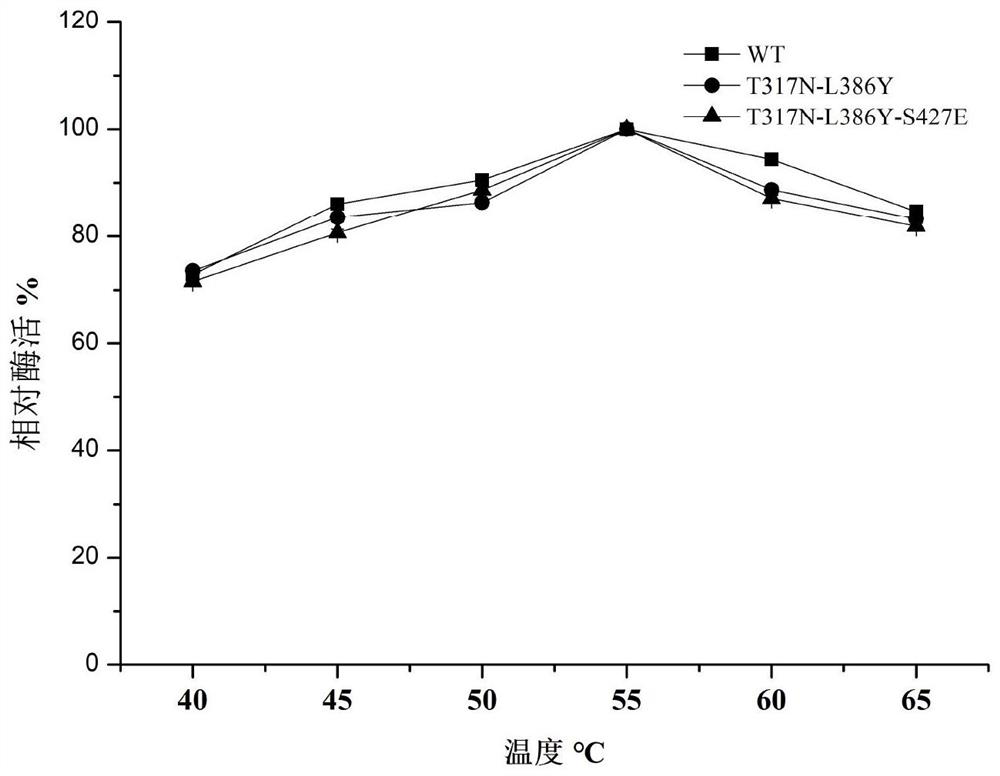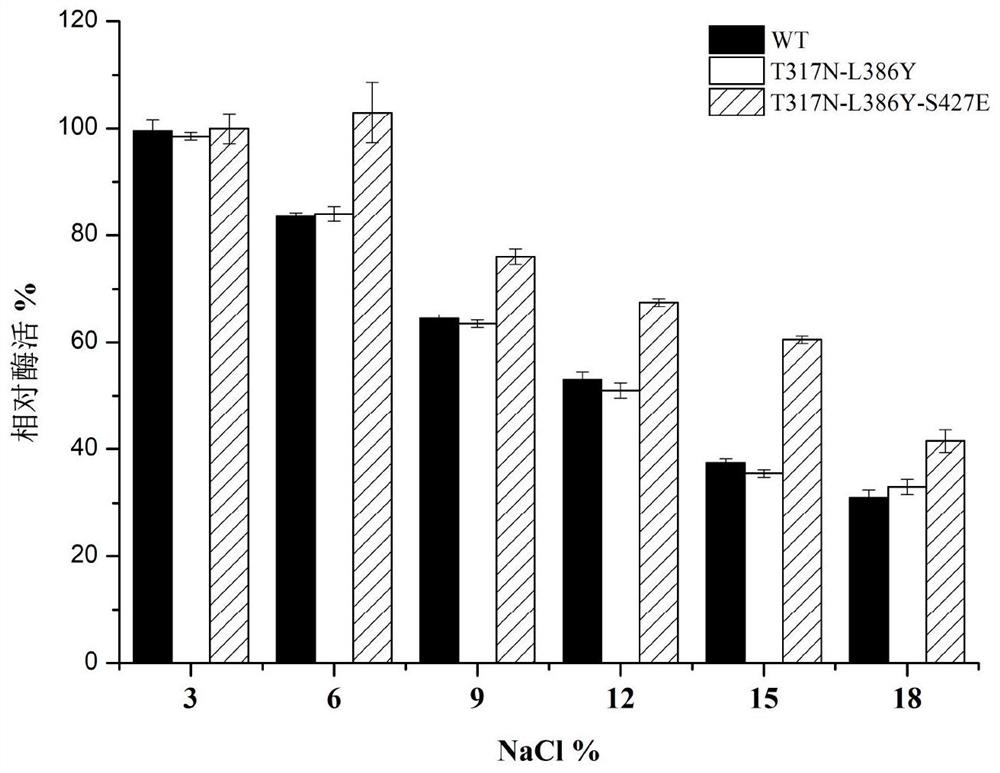A Mutant of Multicopper Oxidase with Improved Salt Tolerance
A multi-copper oxidase and mutant technology, which is applied in the field of bioengineering, can solve the problems of worrying about the safety of adding strains, reducing protein content, and affecting food flavor.
- Summary
- Abstract
- Description
- Claims
- Application Information
AI Technical Summary
Problems solved by technology
Method used
Image
Examples
Embodiment 1
[0030] Embodiment 1: Recombinant bacteria construction
[0031] Select the plasmid pET28a(+) with the T7 promoter as the expression vector, and the pET28a(+) plasmid and the amplified GenBank number is CP011252.1 The indicated mcob gene encoding the unmutated multicopper oxidase (in GenBank number is CP011252.1 The nucleotide sequence shown is followed by the histidine-encoding sequence (CATCATCACCACCACCACTAA) for EcoRI and HindIII double enzyme digestion respectively. After the digestion products are gel-cut and recovered, they are ligated overnight with DNA ligase Solution I, and the ligated products are transformed into large intestine Bacillus JM109 competent cells were cultured at 37°C for 10 hours, and positive transformants were identified by colony PCR.
[0032] Pick 3 positive transformants, inoculate them in liquid LB medium (containing 50 μg / ml kanamycin), culture them at 37°C for 10 hours, extract the plasmids for sequencing verification, and transform the pla...
Embodiment 2
[0033] Embodiment 2: Preparation of mutant T317N-L386Y
[0034] (1) Preparation of mutant T317N
[0035] According to the multi-copper oxidase gene sequence of B. amyloliquefaciens, design and synthesize the primers for introducing T317N mutation, use the rapid PCR technology, and use the expression vector pET28a(+)-MCOB as a template,
[0036] The site-directed mutagenesis primers for introducing the T317N mutation are:
[0037] Upstream primer: 5'-TTTTA AAC AACGGCACCGGCTG-3' (the underline is the mutated base)
[0038] Downstream primer: 5'-GTGCCGTT GTT TAAAATAATATGTTTCTCCG-3' (the underline is the mutated base)
[0039] PCR reaction system: 2 x PrimerSTAR DNA polymerase 25 μL, upstream primer (10 μM) 1 μL, downstream primer (10 μM) 1 μL, template DNA 1 μL, ddH 2 O 22 μL.
[0040] The PCR amplification conditions were: pre-denaturation at 95°C for 3 minutes; followed by 30 cycles (98°C for 30 s, 55°C for 30 s, and 72°C for 7 min); and extension at 72°C for 10 minutes. ...
Embodiment 3
[0050] Example 3: Preparation of mutant T317N-L386Y-S427E
[0051] According to the gene sequence of the multi-copper oxidase of B. amyloliquefaciens, the primers for introducing the S427E mutation were designed and synthesized, and the rapid PCR technology was used to take the vector carrying the gene encoding the mutant T317N-L386Y as a template,
[0052] The site-directed mutagenesis primers for introducing the S427E mutation are:
[0053] Upstream primer: 5'-CACCTGCACTTGGTT GAG TTCCAAGTCCTTGACCGG-3' (the underline is the mutated base)
[0054] Downstream primer: 5'-CAAGGACTTGGAA CTC AACCAAGTGCAGGTGTATCGG-3' (the underline is the mutated base)
[0055] PCR reaction system: 2 x PrimerSTAR DNA polymerase 25 μL, upstream primer (10 μM) 1 μL, downstream primer (10 μM) 1 μL, template DNA 1 μL, ddH 2 O 22 μL.
[0056] The PCR amplification conditions were: pre-denaturation at 95°C for 3 minutes; followed by 30 cycles (98°C for 30 s, 55°C for 30 s, and 72°C for 7 min); and ...
PUM
 Login to View More
Login to View More Abstract
Description
Claims
Application Information
 Login to View More
Login to View More - R&D
- Intellectual Property
- Life Sciences
- Materials
- Tech Scout
- Unparalleled Data Quality
- Higher Quality Content
- 60% Fewer Hallucinations
Browse by: Latest US Patents, China's latest patents, Technical Efficacy Thesaurus, Application Domain, Technology Topic, Popular Technical Reports.
© 2025 PatSnap. All rights reserved.Legal|Privacy policy|Modern Slavery Act Transparency Statement|Sitemap|About US| Contact US: help@patsnap.com



